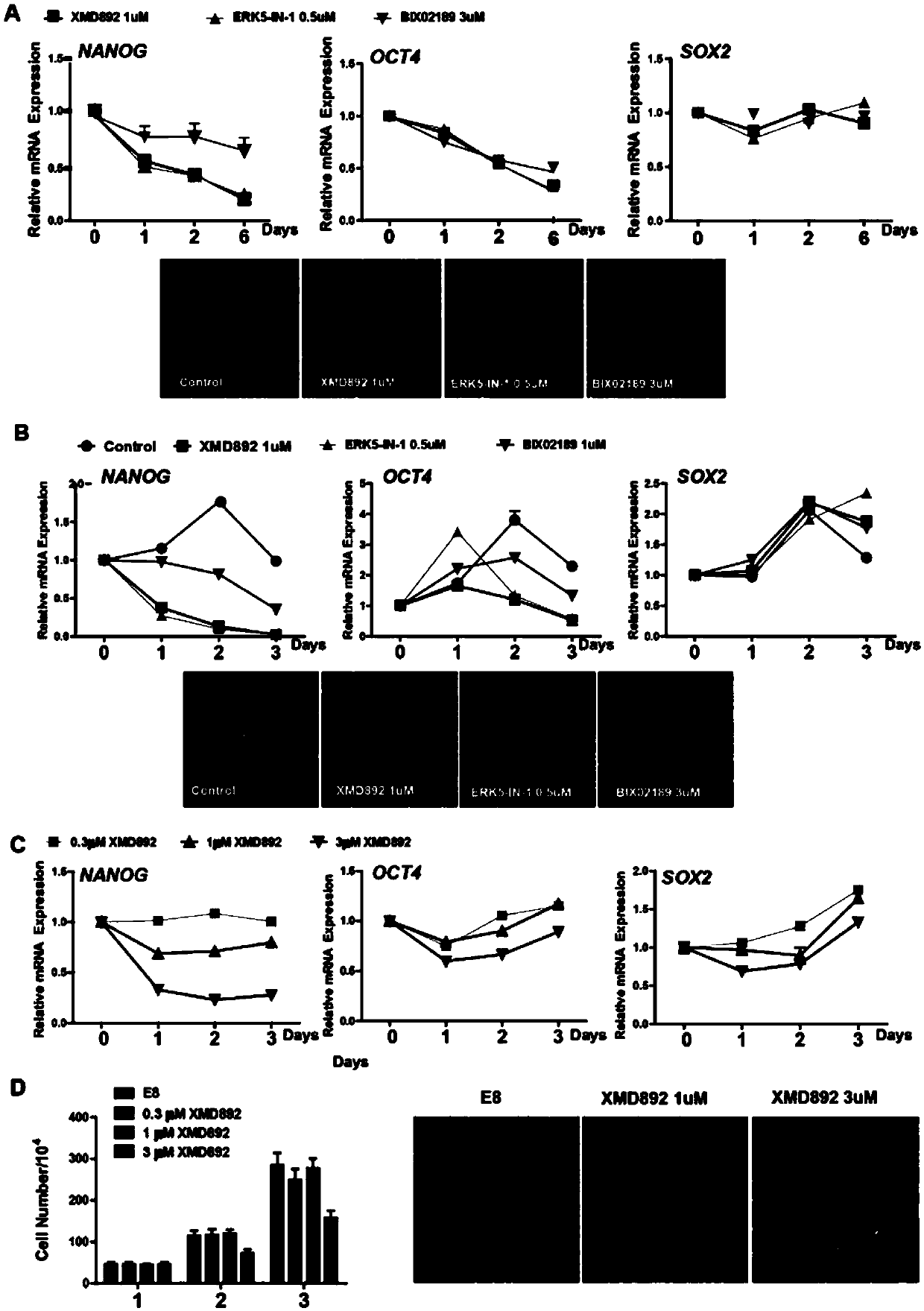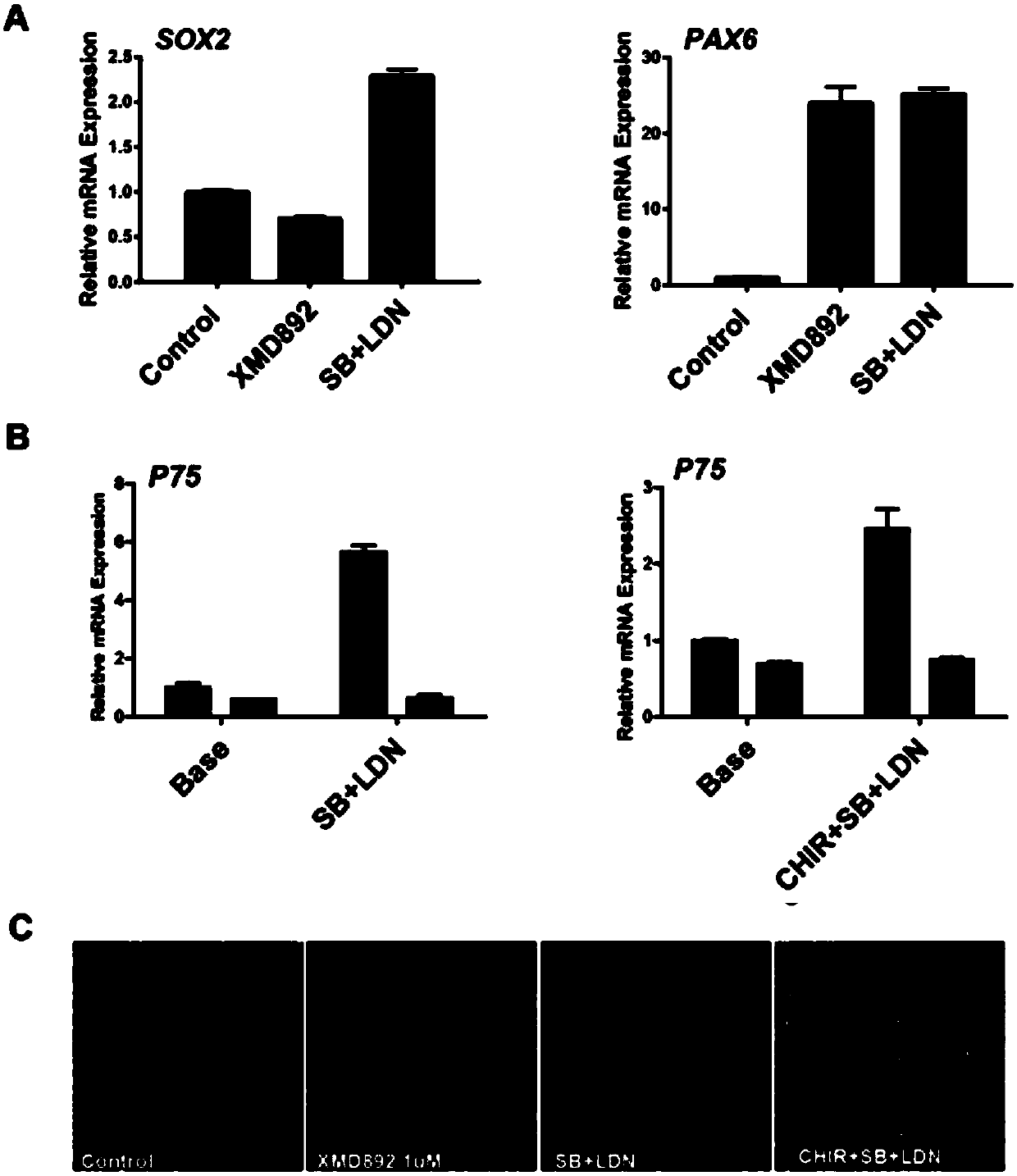ERK5 kinase and application of ERK5 inhibitor in stem cell differentiation
A stem cell differentiation and stem cell technology, applied to embryonic cells, germ cells, animal cells, etc., can solve problems such as differentiation difficulties
- Summary
- Abstract
- Description
- Claims
- Application Information
AI Technical Summary
Problems solved by technology
Method used
Image
Examples
experiment example 1
[0070] ERK5 is essential for maintaining the pluripotency (Pluripotency) of hESCs
[0071] hESCs can maintain unlimited self-renewal and pluripotency, and the genes that maintain pluripotency are widely recognized, NANOG, SOX2 and OCT4. FGF2 and TGFβ are essential for pluripotency maintenance in hESCs for triggering ERK1 / 2 and SMAD2 / 3 phosphorylation to promote NANOG expression. ERK5 is a member of the MAPK family, and experimental results prove that it is also necessary for the maintenance of pluripotency of hESCs. Small molecule chemical inhibitors, ERK5-IN-1, BIX02189 and XMD892 were used in the experiments. ERK5-IN-1 inhibits the binding of ERK5 activators to cell surface receptors, BIX02189 inhibits the phosphorylation of ERK5 by MEK5, and XMD892 inhibits the transcription of ERK5 further phosphorylated into the nucleus. The three inhibitors were added to the E8 medium where hESCs were normally pluripotent, and the inhibitory effect was from day 1 to day 6. All three in...
experiment example 2
[0076] ERK5 Inhibitor Promotes Differentiation of Neuro Progenitor Cells
[0077] In mammalian development, early differentiation of the nervous system belongs to ectodermal development. It has been reported that TGFβ pathway and BMP pathway play a very important and decisive role in the induction of ectoderm. In our experimental system, under the condition of autonomous differentiation in which FGF2 and TGFβ growth factors were removed from E8 medium, after 4 days of differentiation, the ERK5 inhibitor XMD892 not only reduced the expression of pluripotency genes, but also promoted the induction of neural Gene expression level of PAX6 in neuro progenitor cells. Its gene expression level was similar in intensity to TGFβ inhibition (SB431542) or dual inhibition of BMP4 and TGFβ (LDN193189+SB431542) ( figure 2 A). The shape of the cells is shown in the figure ( figure 2 C). What is more noteworthy is that XMD892 not only promotes early neural development, but also greatly ...
experiment example 3
[0080] ERK5 Inhibitor Enhances Extra-embryonic Cells Differentiation and Suppresses Mesoderm Differentiation
[0081] In the in vitro culture of stem cells, hESCs can not only differentiate into the cell types of the three germ layers, endoderm (Endoderm), mesoderm (Mesoderm) and ectoderm (Ectoderm), but also reverse the cell fate and differentiate into the trophoblast of the extraembryonic layer. (Trophoblast) cells. In 2002, Xu et al. (Xu, R.H., et al., BMP4initiates humanembryonic stem cell differentiation to trophoblast.Nature Biotechnology, 2002.20(12):p.1261-1264) proposed that extraembryonic cell types can be differentiated in hESCs After the trophoblast, it greatly complements the application of hESCs in stem cell differentiation. BMP4 can promote trophoblast differentiation in the absence of FGF2, showing extremely high expression of CGA and CGB. The inhibition of TGFβ pathway (SB431542) can cooperate with the action of BMP4 to greatly promote the expression of CGA ...
PUM
 Login to View More
Login to View More Abstract
Description
Claims
Application Information
 Login to View More
Login to View More - R&D
- Intellectual Property
- Life Sciences
- Materials
- Tech Scout
- Unparalleled Data Quality
- Higher Quality Content
- 60% Fewer Hallucinations
Browse by: Latest US Patents, China's latest patents, Technical Efficacy Thesaurus, Application Domain, Technology Topic, Popular Technical Reports.
© 2025 PatSnap. All rights reserved.Legal|Privacy policy|Modern Slavery Act Transparency Statement|Sitemap|About US| Contact US: help@patsnap.com



